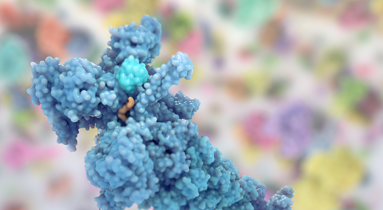Going after the “undruggable”: the STAT3 story

Targeted protein degradation (TPD) is one of the most promising and exciting therapeutic modalities today, with the potential to effectively target disease-causing proteins and signaling pathways that have long been out of reach with conventional therapeutic approaches. These are proteins that either lack catalytic activity and/or have catalytic-independent functions – targets that to date have either gone “undrugged” or have not been adequately addressed.
Over the last 36 months, Kymera has built a protein degrader drug discovery engine – a technology platform allowing us to rationally identify targetable proteins and E3 ligases and develop drug-like degraders with the goal of advancing potent, orally-active compounds. In just a short time, we have demonstrated preclinical proof-of-concept with our small molecule IRAK4 degraders in models of MYD88-mutated lymphoma, an aggressive form of cancer with limited treatment options. And we have identified and initiated drug discovery efforts against several promising new therapeutic targets across different protein classes that have so far been undrugged. We report on our progress here.
IRAK4: Addressing the limitations of kinase inhibition
While IRAK4 is a traditionally “druggable” kinase target, small molecule kinase inhibitors have shown limited efficacy in diseases like MYD88-mutated lymphoma, largely because activation of Myddosome signaling is driven by both the kinase and scaffolding functions of IRAK4. Unlike kinase inhibitors, however, IRAK4 degraders target both functions, leading to complete inhibition of Myddosome signaling and superior activity. Kymera is slated to present preclinical research on our IRAK4 degraders at the upcoming meeting of the American Association of Cancer Research, which kicks off later this month.
STAT3: Going after the “undruggable”
To deliver on the full promise of targeted protein degradation, we need to develop the capability to therapeutically initiate the degradation of traditionally “undruggable” targets – those with no catalytic function and with limited or no technical targeting options. In this category, one of the more exciting opportunities is STAT3, a transcriptional regulator that has been linked to numerous cancers and other inflammatory and autoimmune diseases. It is stimulated by a broad range of activators that include RTKs, cytokines, GPCRs and TLRs. When activated STAT3 becomes phosphorylated, homodimerizes and translocates into the nucleus, where it drives the transcription of genes associated with cell survival, angiogenesis and migration. In healthy cells STAT3 is transiently expressed and tightly regulated, but in certain malignant cells STAT3 activation is set into overdrive, leading to a dampened immune response, tumor progression and metastasis. STAT3’s role as a cancer driver and tumor microenvironment modulator has been validated in a multitude of studies, making it a highly-attractive candidate to target in oncology and immuno-oncology.
Although we’ve known for decades that STAT3 has a major role in cancer, developing an effective drug against it has been a challenge. To date, efforts to target aberrant STAT3 activation have largely focused on disrupting upstream signaling molecules such as JAK, IL-6 receptor and GPCR receptor. Given the broad number of STAT3 activators, though, it’s unlikely that targeting individual upstream regulators can be sufficient to treat cancer. To add to this complexity, STAT3 also has phosphorylation and dimerization-independent functions within the cell that would not be impacted by inhibiting upstream regulators.
Kymera scientists have spent a substantial amount of time working to identify, validate and advance small molecule ligands targeting this transcription factor, all the while improving our understanding of the structure, properties and behaviors of this class of proteins so that we can develop even better ligands in the future. We have recently conquered what is probably the most technically-challenging mountain, by showing that significant, ubiquitin proteasome system-specific cellular degradation of STAT3 can be induced by our small heterobifunctional molecules. In both biochemical and cellular assays, we demonstrated that our degraders engage STAT3 and mediate efficient ternary complex formation with E3 ligases, leading to subsequent ubiquitination and degradation.
While there is clearly more work to be done to deliver a drug candidate, it is important as an industry to share critical milestones that reflect the power of this technology, especially in a space that has not been well documented.
TPD is a new and emerging field that holds the promise to unlock therapeutic targets that were previously not considered to be good drug targets. We at Kymera are excited by our progress and are deeply motivated and committed to harnessing this technology to advance novel medicines for patients who otherwise would have no therapeutic options. Demonstrating the potential to degrade STAT3 is a small but very important step in this journey, opening the door to a new class of protein degrader therapies that can target multiple different protein families. We look forward to sharing more in the months to come.